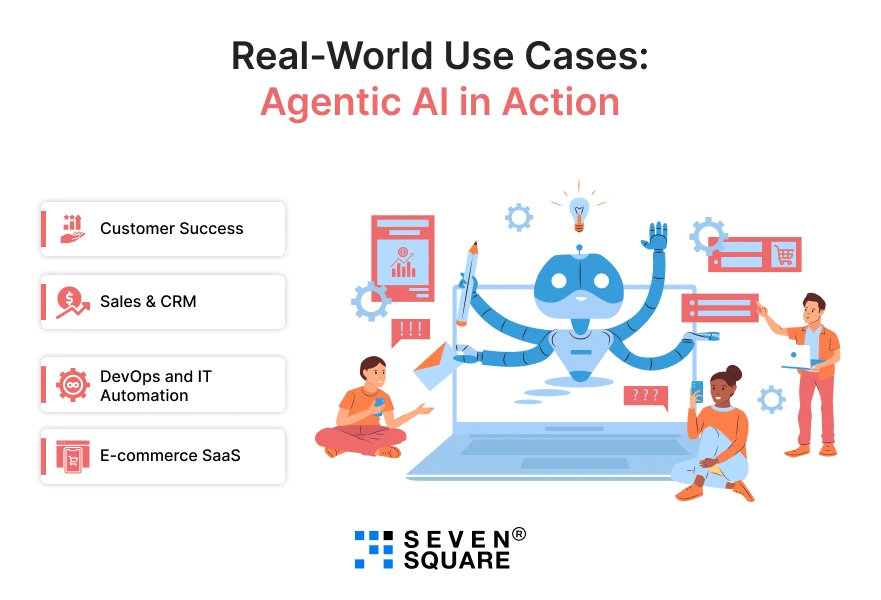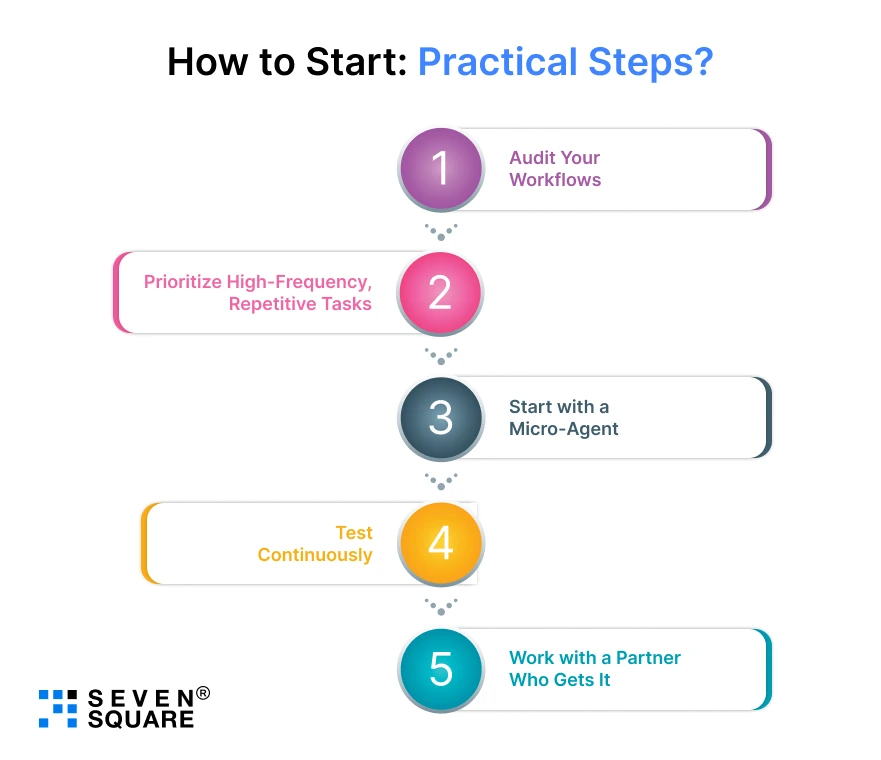You’ve launched a promising SaaS product. Your team is perfect. The roadmap is packed.
Your users expect faster response times, smarter features, and a flawless experience.
But your automation stack is maxed out, your workflows are rigid, and scaling is starting to feel like patching a leaking ship.
At Seven Square, we’ve partnered with businesses that hit that wall too.
And now, they’re unlocking speed, adaptability, and intelligence by integrating Agentic AI which is a growing model that’s changing SaaS automation.
Let’s explore what this shift means and how you can use it to get ahead, not play catch-up.
In this blog, we will explain how Agentic AI SaaS can minimize human error risks and ensure security.
From RPA to Agentic AI: What’s the Difference?
We’ve all seen traditional automation: robotic process automation (RPA), scripts, and Zapier-style workflows.
They follow instructions: if A, then B. But today’s users aren’t static, and neither are businesses.
That’s where Agentic AI steps in.
Unlike rigid automation, Agentic AI agents are designed to observe, reason, and act.
They can plan steps, adapt in real-time, and pursue goals independently. Think of them as mini team members embedded in your product.
Key Benefits of Agentic AI over Traditional RPA:
- Context awareness: Agents react based on data, not rules alone.
- Autonomous decision-making: They don’t just follow; they think.
- Multi-step execution: Handle complex workflows without step-by-step programming.
- Continuous learning: Improve with each interaction.
We recently helped a SaaS client in HR tech replace a legacy onboarding automation with an agentic workflow orchestration.
The result? 45% faster user onboarding and nearly zero drop-offs.
Learn about top 7 AI tools for quick growth of SMEs.
What Is Agentic AI in SaaS?
In the SaaS ecosystem, Agentic AI isn’t just a backend tool, it’s becoming part of the product experience.
From customer support bots that solve real issues (not just reply with canned responses) to marketing tools that analyze context and optimize campaigns in real-time, Agentic AI SaaS solutions are elevating how we build and scale software.
Imagine this: Your support platform auto-deploys a proactive agent when user friction is detected.
Or your product’s billing system adapts dynamically based on usage patterns. That’s not a pipe dream anymore, it’s happening.
Wondering how to build autonomous AI agents?
Real-World Use Cases: Agentic AI in Action

Let’s explore how different industries are using Agentic SaaS automation tools:
1. Customer Success
- Agentic AI agents predict churn, monitor NPS trends, and trigger human intervention when needed.
2. Sales & CRM
- AI agents qualify leads, update CRMs, and suggest next actions based on customer behavior.
3. DevOps and IT Automation
- Agentic workflows monitor performance, auto-resolve low-risk issues, and escalate anomalies.
4. E-commerce SaaS
- Agents manage dynamic pricing, personalize recommendations, and handle returns autonomously.
At Seven Square, we implemented agentic AI in a logistics SaaS platform to manage shipment scheduling.
The AI not only optimized routes but also negotiated delivery windows with customers in real time. That’s the kind of autonomous SaaS workflow we mean.
Agentic AI vs Traditional SaaS Automation
| Feature | Traditional Automation Saas | Agentic AI SaaS |
|---|---|---|
| Rule-driven | Yes | No |
| Reactive | Mostly | Proactive |
| Scalability | Limited | High |
| Learning ability | None | Yes |
| Human-like behavior | No | Yes |
This is not just a tech upgrade, it’s a mindset shift. You’re moving from task-based scripts to outcome-oriented, intelligent agents.
Agentic AI Frameworks and Tools
Some of the most innovative agentic automation frameworks available today include:
- LangChain: Perfect for chaining LLM tasks in SaaS workflows.
- Auto-GPT / OpenAgent: Great for autonomous multi-step task execution.
- ReAct Pattern: Combines reasoning + action, ideal for adaptive decision-making.
These tools let you build Agentic AI SaaS products that aren’t just functional but intelligent.
Building Agentic SaaS Workflows: Our Approach
At Seven Square, our developers don’t just code, they understand product thinking. Here’s how we help you implement Agentic AI in SaaS:
- Deep Discovery: We don’t rush to automate. We understand your workflow, goals, and existing systems.
- Select the Right Agentic Framework: Whether it’s ReAct, AutoGPT, or custom-built agents, we align with your stack.
- Custom Development with Guardrails: We create intelligent agents with fallback protocols, security layers, and observability.
- Pilot & Scale: We start small, measure ROI, and then scale across verticals.
We’ve done this across fintech, HR, healthcare, and logistics. Our promise: clear communication, swift execution, and scalable systems that last.
Want to use Agentic AI to automate your SaaS? Contact Us Now!
Benefits of Agentic AI for SaaS Founders
- Faster Time to Market: Autonomous agents reduce manual QA and process testing.
- Reduced Operational Costs: Minimize human intervention and API bloat.
- Higher User Retention: Context-aware UX feels smarter and more helpful.
- Clear ROI: Every decision by the AI agent is measurable.
If you’re building a modern SaaS product, agentic AI isn’t a “maybe someday” thing. It’s your competitive advantage now.
Agentic AI SaaS: Trends to Watch in 2025
- Composable Agents: Interchangeable skills for fast upgrades.
- Hyper-Personalization: Agents adapt UX based on micro-segmentation.
- Natural Language Workflows: Trigger workflows with plain English prompts.
- Autonomous SaaS Platforms: Full products running with minimal human touch.
How to Start: Practical Steps?

Here’s a simple path for founders to explore Agentic AI:
- Audit Your Workflows: Where are your bottlenecks?
- Prioritize High-Frequency, Repetitive Tasks: Perfect for agents.
- Start with a Micro-Agent: Solve one problem. Scale later.
- Test Continuously: Agentic systems learn; give them data.
- Work with a Partner Who Gets It: Like us.
We build working tech that improves your SaaS.
Agentic AI SaaS is the New Automation
The future isn’t about automating more steps, it’s about delegating outcomes to systems that can adapt, learn, and act. That’s what Agentic AI in SaaS unlocks.
At Seven Square, we’re helping founders build smarter companies with clarity, precision, and engineering that delivers.
So if you’re ready to stop patching workflows and start evolving your SaaS, you know where to find us.
FAQs
- Agentic AI in SaaS means intelligent software agents that autonomously manage and optimize workflows, user interactions, and operations within a SaaS platform.
- These agents go beyond rule-based automation by reasoning, learning, and taking goal-oriented actions.
- Because Agentic AI SaaS solutions provide faster execution, better customer experiences, and lower operational costs.
- In a competitive market, adopting agentic workflows can be the edge that makes your SaaS product stand out in 2025.
- Yes, in many cases, Agentic AI vs RPA shows that agentic systems outperform RPA in flexibility, learning, and complex decision-making.
- They’re particularly effective when automation needs to evolve with user behavior and data.
- Companies implementing Agentic AI SaaS automation report improved retention, higher conversion, and reduced ops cost.
- ROI can be tracked via metrics like task resolution time, user satisfaction, and workflow efficiency.